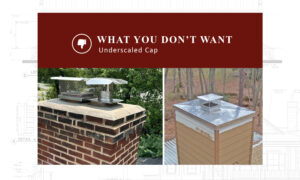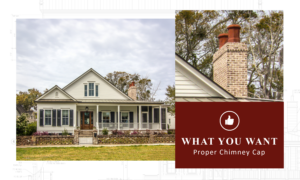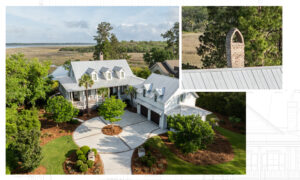Some architectural details are subtle—but powerful. The chimney cap is one of them.
At first glance, it might seem like a minor feature. But step back, and you’ll see that the cap plays an essential role in the silhouette of a home. It defines the termination of the chimney, balances the roofline, and adds a layer of architectural polish that can’t be faked. A well-designed chimney cap finishes the job. The wrong one, though, can undo the effort of otherwise beautiful architecture.
Here’s what we believe is the right approach—and what to avoid.
Why Chimney Cap Design Matters
A chimney cap is more than a functional necessity—it’s a design opportunity. It’s the architectural punctuation mark at the top of your home. In traditional architecture, especially in Lowcountry or Southern coastal styles, the chimney often serves as a vertical anchor to the facade. The cap at the top is what gives it character and proportion.
When done correctly, the chimney cap enhances the overall silhouette of the home. When ignored, it can look like a design miss—a placeholder instead of a finishing touch.
DO: Use a Clay Pot or Proper Masonry Cap
A clay chimney pot is one of our favorite options—and not just for aesthetic reasons. The tapered shape of a pot can help improve draft, and it adds a timeless, handcrafted element that feels in step with traditional architecture.
We also appreciate well-scaled masonry caps—where the brick flares slightly at the top or incorporates a cast stone element. These caps can elevate the entire profile of the chimney and lend a sense of completion.
Why this works:
-
Offers proportion and balance to the chimney
-
Improves function (draft and rain protection)
-
Reinforces the language of the home’s detailing
DON’T: Underscale or Generic Metal Caps
We often see generic prefab caps or poorly sized metal boxes tacked on as an afterthought. Even worse are caps that are clearly underscaled—small rectangles sitting awkwardly atop large brick chimneys.

Why this doesn’t work:
-
Looks unresolved and visually weak
-
Undermines the scale and detailing of the home
-
Distracts from an otherwise cohesive elevation
A Few More Tips We Stand Behind
-
Match the architecture. A chimney cap should feel like it belongs. In traditional homes, that often means a clay pot or a masonry flare. In more contemporary designs, it may be something cleaner and custom—but it still needs to be intentional.
-
Keep proportions in check. The cap should complement the width and height of the chimney—not disappear on top of it or feel oversized.
-
Finish with craftsmanship. Whether you’re using brick, cast stone, or metalwork, the detailing should feel like it came from the same design hand that shaped the rest of the home.
Thoughtful Architecture is in the Details
We talk a lot about the big picture—but we obsess over the small stuff too. Chimney caps may not be the first thing someone notices, but when they’re designed well, they make everything else feel more complete. When they’re not, it’s hard to unsee them.
That’s why we believe every detail, no matter how small, deserves attention. Great architecture isn’t just about the floor plan—it’s about consistency, proportion, and a sense of finish.
So yes, we have opinions about chimney caps. And if you’re building with us, you can trust that we’ll sweat those details for you.
Want More?
We love sharing the little things that make a home truly great. Browse more or get in touch to talk about your project—we’d love to help you get it right from the top down.



